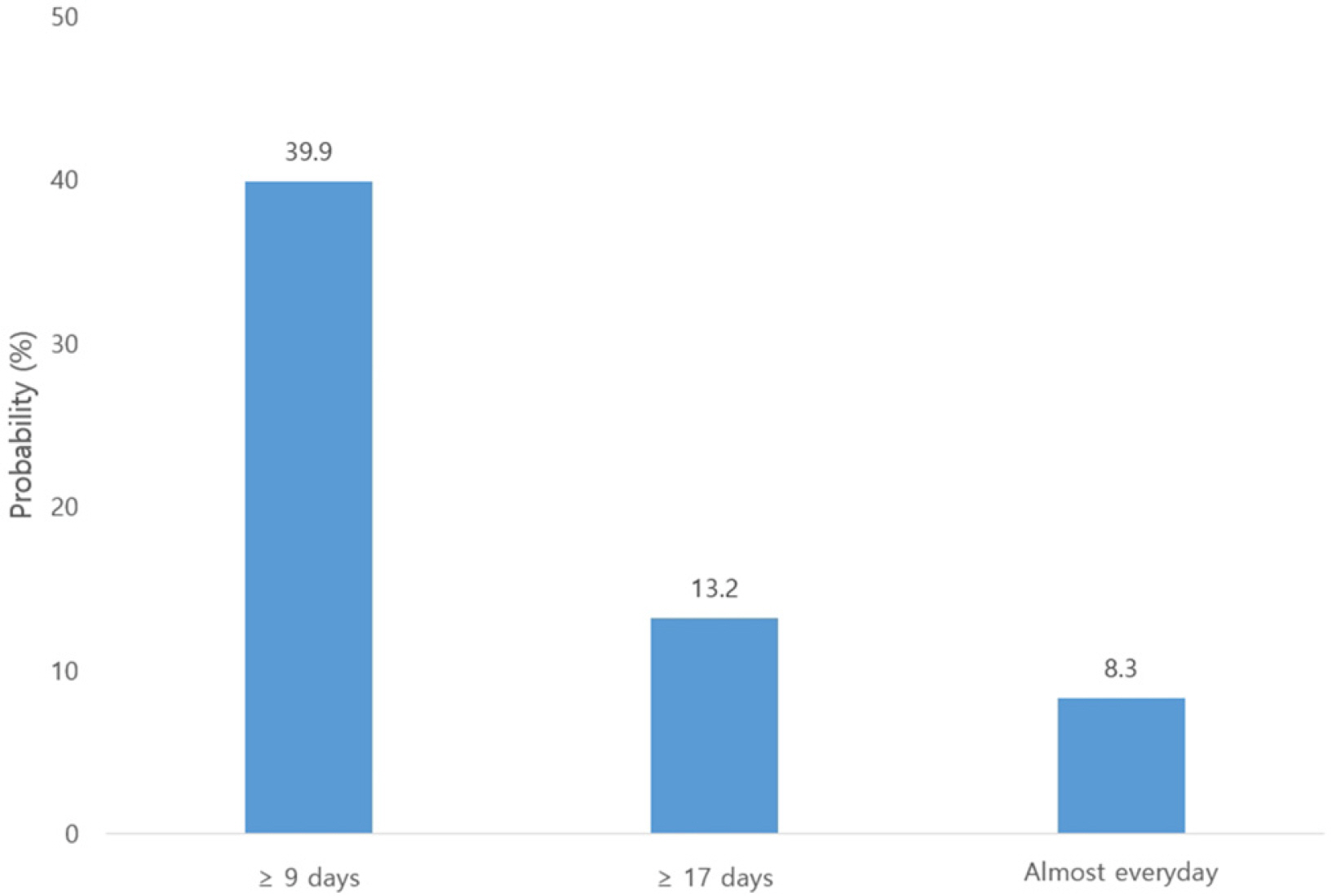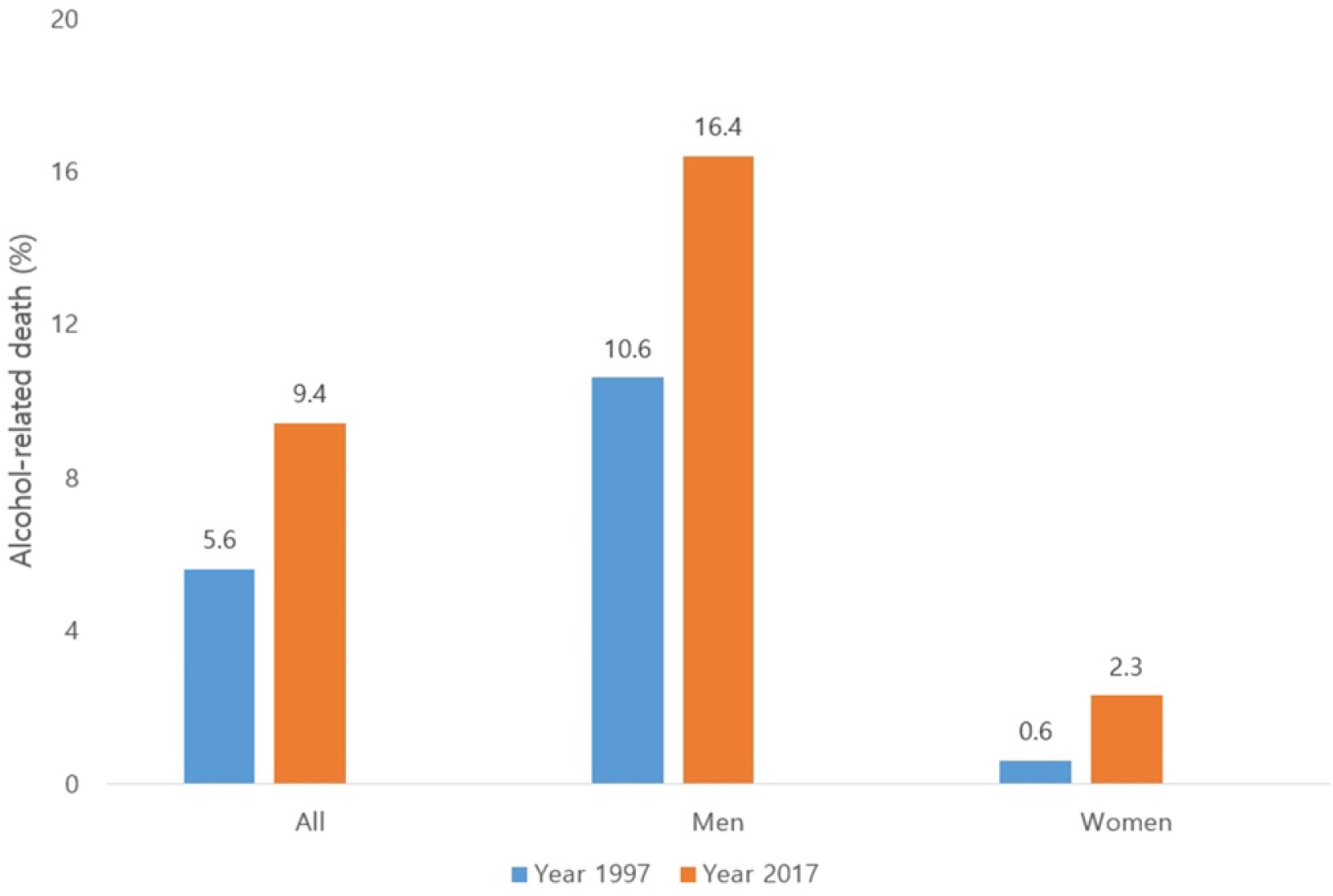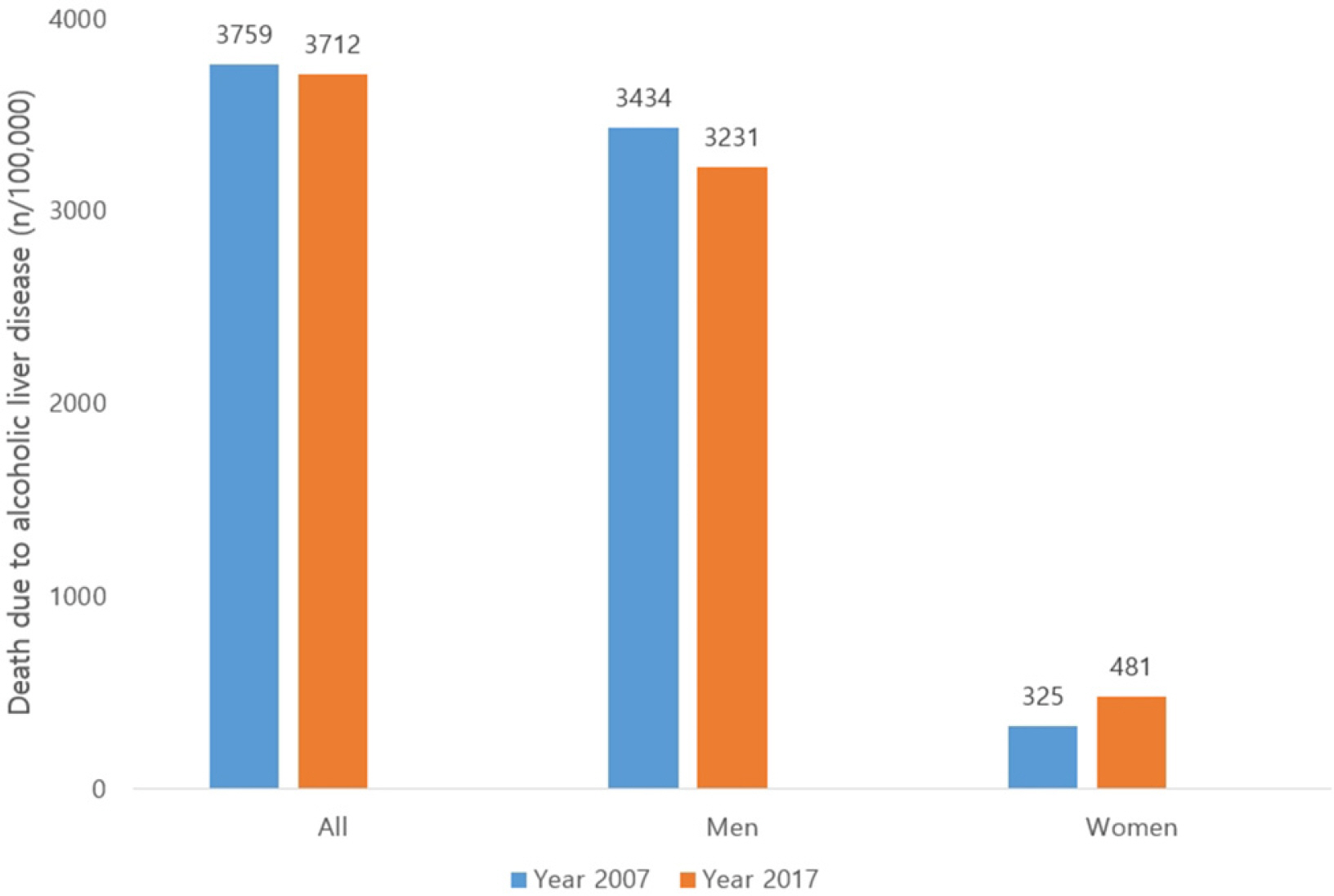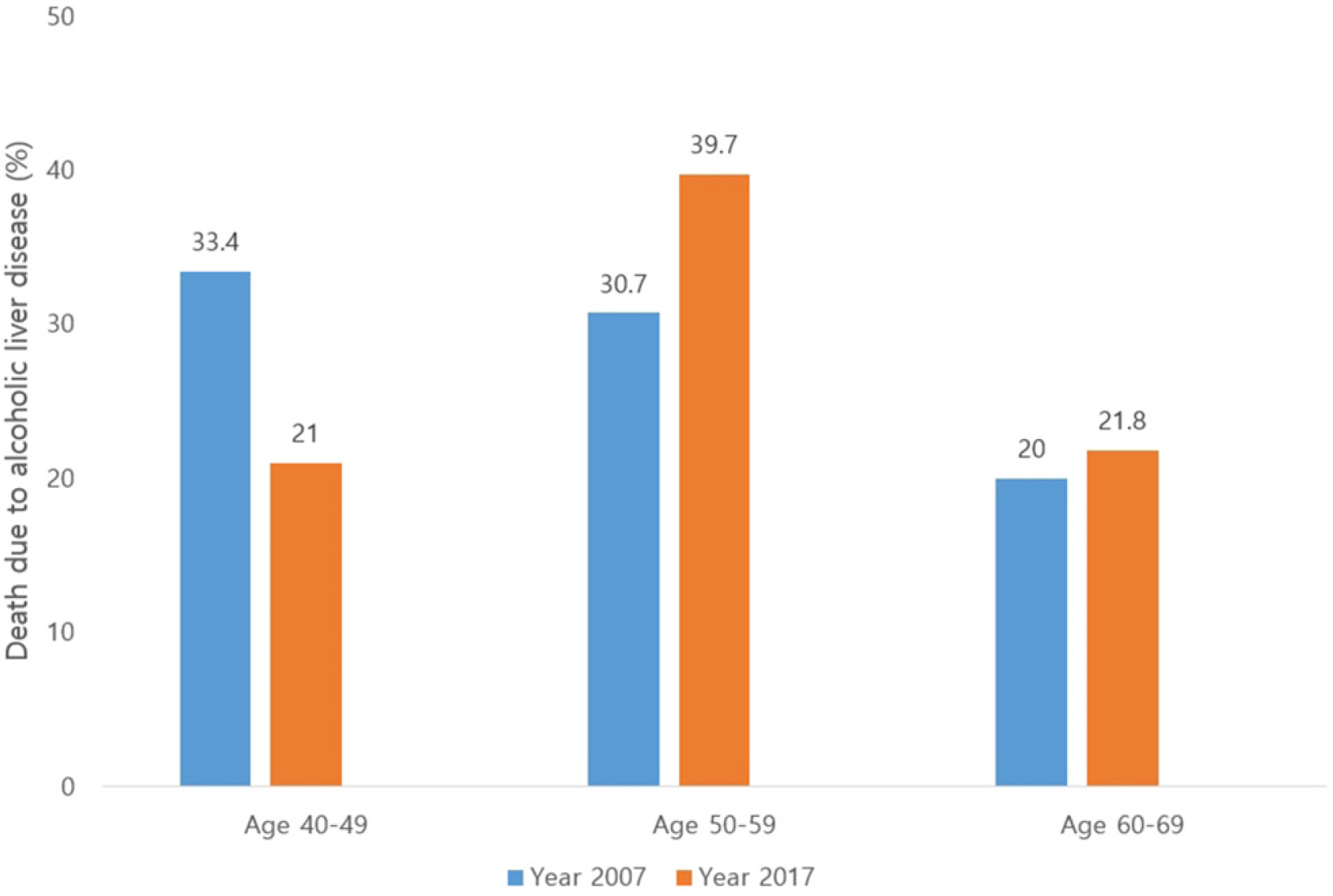Korean J Gastroenterol.
2020 Aug;76(2):55-59. 10.4166/kjg.2020.76.2.55.
Epidemiology of Alcoholic Liver Disease in Korea
- Affiliations
-
- 1Department of Internal Medicine, Bucheon St. Mary’s hospital, College of Medicine, The Catholic University of Korea, Bucheon, Korea
- 2The Catholic University Liver Research Center, Seoul, Korea
- KMID: 2505809
- DOI: http://doi.org/10.4166/kjg.2020.76.2.55
Abstract
- The harmful use of alcohol is associated with significant medical and socioeconomic burdens responsible for approximately 6% ofall deaths worldwide. In Korea, the total alcohol consumption recently decreased slightly from 14.8 L of alcohol per person onaverage in 2011 to 9.1 L in 2015. On the other hand, over the past 10 years (2007-2017), the rates of monthly alcohol consumption,which is defined as drinking more than once a month, and the rates of high-risk alcohol consumption, defined as drinkingmore than seven standard drinks twice a week or more, have increased. In particular, the death rate due to alcoholic liver diseasewas the highest and increasing among those in their 50s who play crucial socioeconomic roles. In addition, the most notablechange over the past 10 years has been the increase in alcohol consumption in young women aged between 20 and 39, and theincrease in deaths among women due to alcoholic liver disease. In Korea, alcoholic liver disease is ranked 2nd-3rd as the causesof chronic liver disease, liver cirrhosis, and hepatocellular carcinoma, having a significant negative socioeconomic impact.
Figure
Reference
-
1. Park H, Shin SK, Joo I, Song DS, Jang JW, Park JW. 2020; Mar. 9. Systematic review with meta-analysis: low-level alcohol consumption and the risk of liver cancer. Gut Liver. [Epub ahead of print]. DOI: 10.5009/gnl19163. PMID: 32135583.
Article2. Bagnardi V, Rota M, Botteri E, et al. 2015; Alcohol consumption and site-specific cancer risk: a comprehensive dose-response meta-analysis. Br J Cancer. 112:580–593. DOI: 10.1038/bjc.2014.579. PMID: 25422909. PMCID: PMC4453639.
Article3. Wang YT, Gou YW, Jin WW, Xiao M, Fang HY. 2016; Association between alcohol intake and the risk of pancreatic cancer: a dose-response meta-analysis of cohort studies. BMC Cancer. 16:212. DOI: 10.1186/s12885-016-2241-1. PMID: 26968702. PMCID: PMC4788838.
Article4. Polsky S, Akturk HK. 2017; Alcohol consumption, diabetes risk, and cardiovascular disease within diabetes. Curr Diab Rep. 17:136. DOI: 10.1007/s11892-017-0950-8. PMID: 29103170.
Article5. Kawano Y. 2010; Physio-pathological effects of alcohol on the cardiovascular system: its role in hypertension and cardiovascular disease. Hypertens Res. 33:181–191. DOI: 10.1038/hr.2009.226. PMID: 20075936.
Article6. Schwarzinger M, Pollock BG, Hasan OSM, Dufouil C, Rehm J. QalyDays Study Group. 2018; Contribution of alcohol use disorders to the burden of dementia in France 2008-13: a nationwide retrospective cohort study. Lancet Public Health. 3:e124–e132. DOI: 10.1016/S2468-2667(18)30022-7. PMID: 29475810.
Article7. Boden JM, Fergusson DM. 2011; Alcohol and depression. Addiction. 106:906–914. DOI: 10.1111/j.1360-0443.2010.03351.x. PMID: 21382111.
Article8. Borges G, Bagge CL, Cherpitel CJ, Conner KR, Orozco R, Rossow I. 2017; A meta-analysis of acute use of alcohol and the risk of suicide attempt. Psychol Med. 47:949–957. DOI: 10.1017/S0033291716002841. PMID: 27928972. PMCID: PMC5340592.
Article9. 2014. Global status report on noncommunicable diseases 2014. [Internet]. WHO;Geneva: Available from: https://apps.who.int/iris/bitstream/handle/10665/148114/9789241564854_eng.pdf?.sequence=1. cited 2020 Jul 20.10. 2011. Global status report on alcohol and health. [Internet]. WHO;Geneva: Available from: https://apps.who.int/iris/bitstream/handle/10665/44499/9789241564151_eng.pdf?.sequence=1. cited 2020 Jul 20.11. Jang JY, Kim DJ. 2018; Epidemiology of alcoholic liver disease in Korea. Clin Mol Hepatol. 24:93–99. DOI: 10.3350/cmh.2017.0079. PMID: 29544241. PMCID: PMC6038943.
Article12. 2013. White paper on liver diseases in Korea. [Internet]. KASL;Seoul: Available from: https://www.kasl.org/bbs/index.html?.code=ency&page=1&number=55&mode=view. cited 2020 Jul 20.13. 2018. Dec. 1. 2017 national health statistics national health and nutrition examination. [Internet]. Ministry of Health and Welfare DCH;Sejong: Available from:https://knhanes.cdc.go.kr/knhanes/sub04/sub04_03.do?.classType=7. cited 2020 Jul 20.14. 2018. Dec. 1. Trends in alcohol consumption survey. [Internet]. Ministry of Agriculture Food, And Rural Affairs;Sejong: Available from: http://www.kalia.or.kr/bbs/board.php?.tbl=bbs12&mode=VIEW&num=29&&mobile_flag=ok. cited 2020 Jul 20.15. Wood AM, Kaptoge S, Butterworth AS, et al. 2018; Risk thresholds for alcohol consumption: combined analysis of individual- participant data for 599 912 current drinkers in 83 prospective studies. Lancet. 391:1513–1523. DOI: 10.1016/S0140-6736(18)30134-X. PMID: 29676281. PMCID: PMC5899998.16. Becker U, Deis A, Sørensen TI, et al. 1996; Prediction of risk of liver disease by alcohol intake, sex, and age: a prospective population study. Hepatology. 23:1025–1029. DOI: 10.1002/hep.510230513. PMID: 8621128.
Article17. 2018. Sep. 19. Cause of death in 2017. [Internet]. Statistics Korea;Daejeon: Available from: http://kostat.go.kr/portal/korea/kor_nw/1/6/2/index.board?.bmode=read&bSeq=&aSeq=370710&pageNo=1&rowNum=10&navCount=10&currPg=&searchInfo=&sTarget=title&sTxt=. cited 2020 Jul 20.18. 2018. Sep. 27. National health insurance statistical yearbook 2017. [Internet]. National Health Insurance Service;Wonju: Available from: https://www.nhis.or.kr/bbs7/boards/B0075/27229?.boardKey=28&boardName=B0075. cited 2020 Jul 20.19. Park SH, Plank LD, Suk KT, et al. 2020; Trends in the prevalence of chronic liver disease in the Korean adult population, 1998-2017. Clin Mol Hepatol. 26:209–215. DOI: 10.3350/cmh.2019.0065. PMID: 31679316. PMCID: PMC7160351.
Article20. Lee YS, Seo YS, Kim JH, et al. 2018; Can more aggressive treatment improve prognosis in patients with hepatocellular carcinoma? A direct comparison of the Hong Kong liver cancer and Barcelona clinic liver cancer algorithms. Gut Liver. 12:94–101. DOI: 10.5009/gnl17040. PMID: 28873509. PMCID: PMC5753690.
Article
- Full Text Links
- Actions
-
Cited
- CITED
-
- Close
- Share
- Similar articles
-
- KASL Clinical Practice Guidelines: Management of Alcoholic Liver Disease
- Epidemiology of alcoholic liver disease in Korea
- Should you advocate for hepatocellular carcinomasurveillance in patients with alcohol-related liverdisease or non-alcoholic fatty liver disease?
- Current status of liver diseases in Korea: Toxic and alcoholic liver diseases
- Are patients with alcohol-related fatty liver at increased risk of coronary heart disease?







